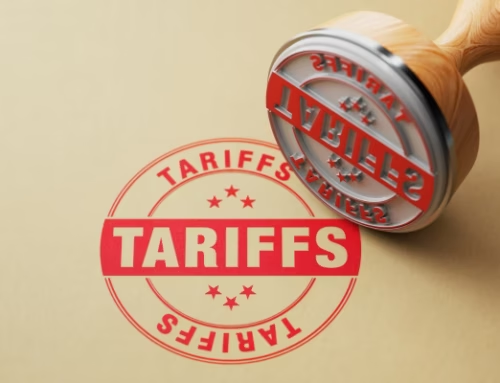The Senate passed the $2 trillion stimulus bill. At 9.3% of the GDP, the size of this package is unprecedented. Below is a comparison to the American Recovery and Reinvestment Act of 2009. The bill will raise the national debt by 8%. The deficit could exceed the Great Recession peak.

Thursday morning brought the sobering but unsurprising news that US initial jobless claims had jumped to a mind-boggling 3.3 million from just 211,000 two weeks ago. If there were any doubt whether recession is here, this should dispel it. We are in a crisis worse than 2008.

According to Oxford Economics, “more than two-thirds of the cash payments will go to households in the bottom three income quintiles.”

Google search activity continues to indicate an unprecedented shock to the labor market.
- Search for “unemployment”:

Search for “file for unemployment”:

As many economists had estimated, about three million Americans filed for unemployment last week. This increase was unprecedented.

How severe will the next quarter’s GDP decline be? Forecasts vary.

The Federal Reserve
The Federal Reserve announced a new set of policy measures designed to stabilize the credit markets and cushion the economic contraction. The scope of some of these actions is unprecedented, going beyond what we saw in 2008.
- Unlimited QE: Purchases of “Treasury securities and agency mortgage-backed securities in the amounts needed to support smooth market functioning and effective transmission of monetary policy to broader financial conditions and the economy.”
- Support for commercial real estate: Including commercial mortgage-backed securities (CMBS) in QE.
- Support for consumers and businesses: Credit facility to provide financing to “employers, consumers, and businesses” ($300 billion).
- Support for corporate bonds: Two facilities to stabilize primary and secondary corporate bond markets. To support the secondary market, the facility will purchase ” corporate bonds issued by investment grade U.S. companies and U.S.-listed exchange-traded funds…”
- Support for consumer credit: Issuance of debt “backed by student loans, auto loans, credit card loans, loans guaranteed by the Small Business Administration”
- Support for municipal finance:
- Expansion of the Money Market Mutual Fund Liquidity Facility to “include a wider range of securities, including municipal variable rate demand notes and bank certificates of deposit.”
- Including “tax-exempt commercial paper as eligible securities” in the Fed’s commercial paper facility.
- Support for small and medium-sized businesses: “Main Street Business Lending Program to support lending to eligible small and medium-sized businesses, complementing efforts by the SBA.”
Over the past five years, there has been an unprecedented divergence between the unemployment rate and the US federal deficit. The government was pumping significant fiscal stimulus into a growing economy, which, in combination with low interest rates, inflated asset prices.

We have a battle going on between the extent of the damage being done to the economy and the massive response from government. A two-month global business shutdown drops global growth an estimated 7% to 11%. A three-month shutdown hits the global economy somewhere between 10% and 20%. The House passed the $2 trillion rescue package Friday. It is likely that the Fed will put another $4 trillion on its balance sheet in the coming months. But make no mistake, we are not facing a mild recession; we are fighting to prevent depression. My guess is the U.S. will need $5 trillion in financial support, or 25% of U.S. GDP, to get back on its feet. It could be more. I could be wrong. Problems remain:
- We entered this recession in a much weaker condition than we were in going into the last recession (the 2008 Great Financial Crisis). Last time, China was the world’s growth engine. That is hardly the case today. Global trade was positive in 2008. Global trade was negative at the end of 2019.
- We sit at the end of a long-term debt cycle. The last one ended in the 1930s. Few of us have witnessed a period like this. They are different than the short-term debt cycle resets that happen in recessions. Different means the impact is exponentially greater. Factor this into your risk thinking.
- If we look back to the events of the last two recessions, markets will remain vulnerable for many months.
- Business has never before shut down on a global scale. The current recession will likely be as severe as the last two. Given the growth in debt since 2008, it could be more severe. Depends on the extent and timing of fiscal rescue.
- Governments are doing the right thing. $2 trillion is just the start. It will take time to repair the “closed for business” damage. We don’t know what the next bailout package will look like.
- Globalization has peaked, and global supply chains are being reset. Imagine an automobile manufacturer waiting for a small part that is holding up an entire assembly line. That process slows global growth.
- Supply chains will be brought closer to home, with domestic and regional suppliers taking over. But it takes time to reset. For example, 90% of U.S. pharmaceuticals are manufactured in China.
- Prices to produce goods will go up, which will have inflationary implications. It will cost more to produce in the U.S. than what it cost to produce the same goods in China. Higher labor costs.
- The longer the excessive buildup of debt, the longer the duration of downside pain… it will take time to come down, and bankruptcy rates will be huge.
- Government debts will explode to the upside, as will government deficits. We will most likely monetize the debt—a debt jubilee.
- Median fair value on the S&P 500 Index is at 2,333. It is based off the prior 12 months of actual earnings. The “E” in P/E (price-to-earnings ratio) will likely come down, maybe by as much as 20%. That means fair value may be between 1,800 and 2,000, not 2,333. So, I’d remain patient and set initial targets at those levels.
- As the cost of producing goods goes up, profit margins will be squeezed, further reducing earnings. Thus, I believe the best buying opportunities will come at levels below fair value mentioned above.
- We are likely facing a 50% decline, and not a 35% decline. In my view, the best entry point for the S&P 500 Index is around 1,600. No guarantees, of course. Expect trading range markets for the next decade. Active management like ours will be back in favor. Buy and hold strategies will be unprofitable.
- Markets rarely revert back to fair value; they drop down below it due to investor fear and forced margin-call selling.
- Global central bankers, including the Federal Reserve, will keep interest rates at or below zero for some time to come. I don’t believe the Fed will move to negative interest rate policy.
- More defaults, lower bond ratings, and the unwinding of leverage. Borrowing costs for corporations will increase.
- Watch the European banks. The U.S. and Japan have the fiscal structure (via a government bond market) to create new debt. European markets face a structural challenge. There is no common Treasury market like we have in the U.S. The Fed can create dollars to buy Treasury bonds. The European Central Bank can create euros though its member banks, but there is no common Treasury bond market to back its currency. It’s a flaw from the outset of the EU structure. This means the ECB must rely on approval from its member states to be able to expand the money supply. That’s like the Fed having to ask each of the 50 U.S. states for approval to print dollars. The backing of banks is also different. In the U.S., reserves are held in U.S. Government securities. In Europe, they have holdings in French bonds, Italian bonds, Greek bonds, German bonds, etc. Since the sovereign debts are not consolidated, will the northern countries vote yes to bail out the borrowing sins of the southern countries? Doubtful. If the banks are in trouble, the only tool the ECB has is to lower rates. Bottom line: If a bank in France gets in trouble, the bank depositors will be stuck with the losses. It’s called a “bail-in” and that day may be nearing. The U.S.’s corporate debt-to-GDP is 80%, and we know that’s a big problem. Italy’s corporate debt-to-GDP is 100%. It is 200% in France. Watch the EU banks. They’ve been under pressure and I suspect there are greater challenges ahead. Expect “bail-ins.”
- U.S. banks and investors have thousands of cross trades with EU banks. In the 2008 crisis, it was a U.S. leveraged mortgage-driven crisis that affected the globe. Don’t underestimate the risks to U.S. banks and institutions now with this crisis. Frankly, I believe this accounts for some of the dysfunction we are seeing in the repurchase (repo) markets.
- The biggest challenges show up where leverage is greatest. Emerging Markets are the most at risk because they were the ones that created the biggest credit excesses since the last crisis. And much of that was borrowed in dollar-denominated debt. Avoid Emerging Market stocks and Bonds for now.
Expect a 6- to 18-month recession and about four years before affected industries fully recover.
In just these past few weeks, the Fed has cut rates by 150 basis points to near zero and run through its entire 2008 crisis handbook. That wasn’t enough to calm markets, though — so the central bank also announced $1 trillion a day in repurchase agreements and unlimited quantitative easing, which includes a hard-to-understand $625 billion of bond buying a week going forward. At this rate, the Fed will own two-thirds of the Treasury market in a year. The response? The good stock days last week and then a down day Friday. No follow through? That is a bad sign. It shows lack of confidence in the Fed’s ability to offset the effects of the virus on our economy.
How is the Fed doing all of this? New programs:
- CPFF (Commercial Paper Funding Facility) – buying commercial paper from the issuer.
- PMCCF (Primary Market Corporate Credit Facility) – buying corporate bonds from the issuer.
- TALF (Term Asset-Backed Securities Loan Facility) – funding backstop for asset-backed securities.
- SMCCF (Secondary Market Corporate Credit Facility) – buying corporate bonds and bond ETFs in the secondary market.
- MSBLP (Main Street Business Lending Program) – Details are to come, but it will lend to eligible small and medium-size businesses, complementing efforts by the Small Business Association.
To put it bluntly, the Fed isn’t allowed to do any of this. The central bank is only allowed to purchase or lend against securities that have government guarantee. This includes Treasury securities, agency mortgage-backed securities and the debt issued by Fannie Mae and Freddie Mac. An argument can be made that can also include municipal securities, but nothing in the laundry list above.
So how can they do this? The Fed will finance a special purpose vehicle (SPV) for each acronym to conduct these operations. The Treasury, using the Exchange Stabilization Fund, will make an equity investment in each SPV and be in a “first loss” position. What does this mean? In essence, the Treasury, not the Fed, is buying all these securities and backstopping of loans; the Fed is acting as banker and providing financing. The Fed hired BlackRock Inc. to purchase these securities and handle the administration of the SPVs on behalf of the owner, the Treasury.
In other words, the federal government is nationalizing large swaths of the financial markets. The Fed is providing the money to do it. BlackRock will be doing the trades.
This scheme essentially merges the Fed and Treasury into one organization. So, meet your new Fed chairman, Donald J. Trump.
Debt
We sit at the end of a long-term debt super cycle and find ourselves extremely leveraged and swimming in debt. The financial system is unstable. It is the biggest investment challenge we face.
The recent disruptions—especially in the bond markets—are due to leveraged investors racing for the exit doors.
Here is the bottom line:
BBB-rated corporate bonds, which make up a majority of the investment-grade corporate universe, are a major concern. Many of these BBB-rated companies don’t pass the criteria to be rated BBB by the rating agencies anymore. The rating agencies, however, have shown forbearance by adopting a more liberal interpretation of either cash flow coverage or asset coverage, and accepting promises that these companies will de-lever. There are approximately $1 trillion worth of investment-grade corporate bonds that are in danger of being downgraded. Currently, the high-yield market has approximately $1 trillion outstanding; meaning the size of these possible downgrades would double its size. I do not believe that the current concessions on high yield in terms of their spread to Treasuries or absolute yields is sufficient to clear that supply.
Ultra-low rates incentivized corporations to buy back their shares, bidding up stock prices and engineering better earnings. Bottom lines haven’t been growing. Earnings per share went up because the denominator went down (there were fewer shares in the markets). Yet, all the new debt used to fund share repurchases continues to sit on the balance sheets.
If a bond is downgraded from BBB, it jumps into the “junk” category, and those institutions, by mandate, are forced to sell. Market makers and other intelligent investors will see it coming and step aside. The sheer size of the wave of downgrades will reprice the bond market. Will the U.S. government want to buy the debt? This is a ticking time bomb.
A default wave remains ahead.

The number of bonds traded at distressed levels approaches 2009 highs.

A large proportion of US small businesses will run out of cash soon.

Coronavirus Update
Germany seems to be following Italy’s coronavirus trajectory.

Where do older Americans live?

Where are the various countries in the coronavirus “cycle”?

Thursday was not a good day for the US in terms of the number of new infections.

The cumulative number of US cases has now exceeded that of China.


Iran’s new cases keep climbing.

I have NEVER seen or read a more thorough, fascinating discussion of the history of epidemics and their sources. Fascinating! The video is NOT about eating fruits and veggies. It is truly fascinating! I know, it is long, so just have it on and listen in while you are doing something or while driving. Pandemics: History & Prevention
Wash Your Bags
“The eight states where lawmakers have imposed plastic bag prohibitions are California, Connecticut, Delaware, Hawaii, Maine, New York, Oregon and Vermont, according the National Conference of State Legislatures,” columnist Patrick Gleason writes. “Six of those statewide bag bans were enacted as recently as 2019. Hundreds of cities, towns, and counties have also imposed a bag ban or tax. All of these laws seek to force or encourage the use of reusable shopping bags, which pose a public health risk at any time and especially during the current pandemic.”
Not just during a pandemic. A 2011 study was undertaken by researchers at the University of Arizona and Loma Linda University. They collected reusable bags at random from grocery shoppers in California and Arizona, after which they conducted interviews with their owners.
What they discovered was problematic, to say the least. First, most owners seldom, if ever, washed their reusable bags. Second, many used them for multiple purposes.
The result of such practices? “Large numbers of bacteria were found in almost all bags and coliform bacteria in half,” the research stated. “Escherichia coli were identified in 8% of the bags, as well as a wide range of enteric bacteria, including several opportunistic pathogens. When meat juices were added to bags and stored in the trunks of cars for two hours, the number of bacteria increased 10-fold, indicating the potential for bacterial growth in the bags.”
It gets worse. A 2012 study revealed that nine members of a soccer team contracted the norovirus, described by the Centers for Disease Control (CDC) as a “very contagious virus that causes vomiting and diarrhea” simply by touching a reusable bag, or eating the food contained in it. In what might be seen as the essence of unthinking behavior, the bag had been stored in a bathroom. “That might seem like an outlier,” columnist Angela Logomasini explains, “but people cart these bags all over the place, touching surfaces on public transportation, taking them into public bathrooms, and other places, creating lots of opportunities for the bags to pick up bacteria and viruses.”
Such opportunities were not limited to picking up bacteria and viruses. A 2018 study published by the National Environmental Health Association used a non-infectious proxy virus to assess the probability of norovirus transmission related to reusable bags. It revealed that shoppers with such bags transmitted that virus all over the store, including high concentrations of it on the hands of the shoppers themselves, as well a grocery checkout clerks.
According to the 2011 study, washing such bags would remove more than 99.9% of the bacteria on them. A survey conducted at the University of Arizona, however, revealed that only 3% of bag owners ever wash them.
Now add coronavirus to the mix. Any questions?
Market Data
- This is like 2008 in terms of financial losses and severity of selling, but policies have been much more aggressive.
- Earnings growth consensus estimates continue to tumble.

- Volatility in equities across the world over the past month has gone through the roof. In many ways this can only be compared to 1929, 1987, 2001-2002, and 2008.
A Little Humor

All content is the opinion of Brian Decker





